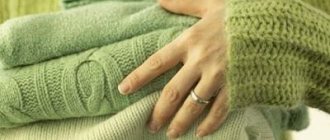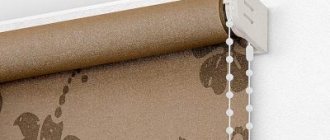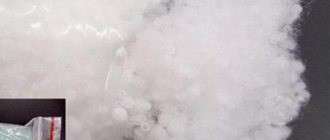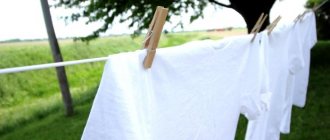Updated: 11/01/2021 14:39:28
Expert: Panteleeva Irina Vladimirovna
The main rule for washing things: colored - to colored, dark - to dark, light - to light. This distinction will prevent the clothing items from changing color. However, there are many more tips for caring for colored clothes: if you neglect them, you increase the risk of experiencing discoloration, staining of your favorite bright things, and streaks appearing on them.
We have prepared a list of recommendations for properly washing colored items. Follow them to maintain the brightness and original condition of colored clothing for a long time.
General recommendations
- Sort clothes by color: orange items with red items, blue items with purple ones. If any item of clothing is very different from the overall color scheme, wash it separately. Do not load white or light-colored clothes into the drum together with colored items;
- Items with heavy stains should be washed in water at a minimum temperature (optimal - 30 °C, maximum - 40 °C). Hot water will only help set the stain.
- Also, before washing, strong stains should be treated separately: apply a stain remover to the stained area and rinse the clothes;
- You cannot soak colored clothes for a long time - otherwise their color may lose its brightness.
Attention! Any new colored item must be washed by hand for the first time, as some of the paint will be washed off.
Do not use chlorine-containing detergents for washing, otherwise the fabric will be discolored. Buy special store-bought products for colored linen. As a result, you will not only preserve and fix the shade of the item, but also ensure its saturation after several washing cycles.
Note to the hostess
- When caring for items, special attention should be paid to the instructions on the tag or label.
- Always follow the temperature recommendations, otherwise the color of the product may change.
- Sort items correctly: it is recommended to wash red items together with items colored in purple, orange, and yellow shades; blue with green things. If there are only a few colored items, you can wash them by hand.
- All items must be turned inside out before washing. This measure will help protect things from shedding.
- Do not fill the drum completely.
- Bright clothes do not tolerate hot water, so it is recommended to wash them in modes with a maximum temperature of no higher than 40 degrees.
- Under no circumstances should items be left in the washing machine drum after the end of the washing program. This can lead to damage to things: they may fade.
- Do not use care products containing chlorine.
- Place colored items spaced apart on the dryer.
Colored products help us look stylish and bright in any situation. To keep things looking attractive for a long time, it is important to wash them correctly! Simple recommendations for caring for colored items will ensure their original appearance.
Testing fabric for color fastness
Before washing, you should check whether the clothes are fading. Lightly wet it in some place, then apply a light-colored cloth or paper napkin to it. Staining a napkin indicates that the item is subject to shedding.
There are other ways to check fabric:
- Cut a piece of fabric near the seam and place it in a small container of alcohol for 5 minutes. Press the cut piece onto the clothing and compare the colors. If the color saturation of the cut part has decreased, then these clothes will quickly fade;
- Pour warm water into a bowl and add powder. Place a piece of clothing in the container for 10 minutes. Place the piece in a white cloth and squeeze it out of the water. If colored streaks appear on white fabric, it means the item is susceptible to fading.
There is a fabric color that is fragile; it is recommended to wash clothes less often and by hand, at a minimum temperature, with careful movements.
Traditional methods
What proven recipes will help restore clothes to their former beauty? This group includes:
- Laundry soap. Grate one block of this product and mix with “Whiteness” (no more than 1 cap). Pour boiling water and wait until completely dissolved. Place a white blouse or T-shirt in this mixture and leave to soak for 2-3 hours. Then rinse well and wash as usual. In addition, you can use one more method. To do this, moisten the cloth with water and thoroughly soap it with laundry soap.
- If a wardrobe item becomes stained during normal washing, wash it by hand using dishwashing detergent (just one cap for a standard five-liter basin of water is enough). This method can be used if the stains are still wet.
Do not mix chemicals from different companies. This can lead to unexpected and not always good results. Also, do not combine chlorine-containing substances with ammonia chemicals.
This will lead to the dissolution of the fibers of the material, but even worse, it can cause health problems. For example, cause nausea and even vomiting.
Preparatory actions
Before washing any new item, read the information on its label. Manufacturers always warn that an item, for example, can only be washed by hand or dry cleaned.
In order to prepare an item for washing, you must:
- Remove key fobs, keys, cards, coins and other small items from your pockets;
- Unfasten the buttons and at the same time fasten all fasteners and buttons;
- Remove pins, belts;
- Turn the clothes inside out;
- Straighten and smooth the sleeves of your shirts.
Place your underwear in a separate washing bag.
White and colored. Can it be washed with one detergent?
How to wash colored and white items? Separately, otherwise white may become colored. Everyone knows this. Some people trust the expert opinion and experience of others in this, while others have tested it with their own example. Basically, the result of such incorrect washing is felt immediately.
But how to wash whites and colors? Is it possible to wash colored items with white powder and vice versa? Here the error, of course, will not immediately lead to a disastrous result, but will appear after several washes.
But why test it from your own experience and then get upset when you can learn from the experience of professionals.
So, you need to wash things only with appropriate means!
Why?
- Products for white contain bleaches, which are aggressive to colored patterns and dyes on fabric: the color may fade or blur.
- Products for whites often contain a white stain remover, which also has a negative effect on colored fabrics.
- Color products contain special additives that remove stains and add brightness to colored fabrics. White may turn gray or yellow over time.
There are also universal products that do not contain any bleaches or color enhancers. They can wash any fabric.
How to wash colored clothes by hand
Thanks to hand washing, the bright, rich color of the item will remain for a long time.
Procedure:
- Fill a bowl with water at room temperature;
- Add a product intended for colored laundry to the water. It should contain no bleaching components;
- Soak clothes for 30 minutes if they are dirty;
- Wash contaminated areas carefully;
- Rinse clothes in clean water with added conditioner;
- Squeeze lightly and hang to dry.
Before washing clothes, we recommend testing the water softness. Pour 25 g of soap into 250 ml of boiling water. If the soap dissolves completely in the water in a short time, it means the water is soft enough. If not, add baking soda or water softener when washing.
Technology for washing contrasting items
The best way to clean items of contrasting colors is hand washing in low temperature water. At the rinsing stage, you can pour a vinegar solution into the water. You need to start washing immediately, without soaking the items in hot water.
Linens in contrasting shades can be washed together if neither item is dyed. You can check this by soaking a fragment of the fabric of the product in a basin of warm water. In case of water staining, the item can only be washed separately from others.
Selecting a washing mode
When using a washing machine, it is better to use the fast or normal mode without activating the “Spin” function and set the temperature to 30 - 40°C.
Temperature
The clothes will delight the owner for a long time with the brightness of their colors and will not lose their shape if they are not exposed to hot water. Also, the type of material matters.
Water temperature for specific fabrics:
- cotton – up to 60°C;
- synthetic – up to 40°C;
- silk - up to 30°C;
- wool – up to 40°C;
- membrane – up to 40°C;
- with prints – up to 40°C.
This scheme must be followed regardless of the washing method.
Bleach and powder
Bleach is used as a stand-alone means to make materials white, and they are used together with washing powder to provide a more pronounced whitening effect and combat stains.
You can add bleaching agents every time you wash light-colored laundry.
But, there are bleaches containing oxygen. Such products are used at a water temperature of 90°C. The best effect from their use is achieved when washing laundry is white. The spots usually have different origins. Oxygen bleach is designed to remove plant stains and works at high temperatures.
Pre-wash in a machine or soak by hand - you can do it with the selected product, and add bleach at the main stage of the cleaning process.
Advice! Bleach designed for use at low water temperatures can be used at any stage.
How to wash colored clothes in a machine
Washing machines do not have a special mode for colored items. Therefore, it is enough to set the temperature to 30 °C. Suitable spin mode is up to 800 rpm.
To prevent the fibers from thinning, wash your clothes inside out. And between the top of the drum and the laundry there should be a space the width of your palm.
Preference should be given to liquid detergents. So, in stores there is ALPI gel concentrate for colored items, which prevents fabric from fading and maintains brightness and color saturation even after repeated washing.
Immediately after finishing washing, remove the clothes from the machine and hang them up. If things continue to lie together, they may become mutually colored.
Is it possible to wash sneakers and sneakers in a washing machine?
Have you ever thought about washing your sneakers in a machine? Your sneakers have very high wear resistance, they can withstand dirt, rain and long walks.
The sneakers are also able to pass the strength test in a washing machine drum. Simply throw a towel inside for cushioning, which will also prevent curling during washing. We also advise you, if possible, to remove the insoles and laces and wash them separately.
Washing your sneakers in the washing machine can be an expensive mistake. A harsh wash cycle can shrink your sneakers and reduce their softness.
To avoid this, it is better to wash your sneakers by hand and then let them dry naturally.
Do's and Don'ts: Backpacks and Sports Bags
You can safely wash your backpack in a washing machine if it is not decorated with various keychains, beads, stickers and a lot of zippers. Additional accessories will most likely come off in the washing machine and ruin your backpack.
To wash a regular backpack or bag, it is better to turn it inside out, place it in an old pillowcase or mesh bag and wash it on a gentle cycle.
Folk methods for washing colored laundry and restoring shade
- In order to wash workwear or other heavily soiled items, prepare a special mixture. Add laundry soap, soda and kerosene to boiling water, place clothes in the solution and leave to soak overnight;
- Mohair items should be rinsed in water with glycerin. For 10 liters of water you need 3 tsp. glycerin;
- To wash blue items, use blue dye. Dissolve the paint in water so that its shade matches the shade of the clothing;
- If cream or beige clothes have faded, add coffee or tea leaves to the water;
- If the clothes are green, add a little green to the water, soak the clothes in it for 10 minutes and rinse. Be sure to wear gloves;
- To wash blue, yellow, pink items, add vinegar to the water, and salt for red and blue items;
- Ammonia will help preserve the brightness and richness of the pink color. To do this, simply add 2 tsp to the compartment with the powder or gel. alcohol
Black pepper will also help ensure color retention. The main reason for discoloration of fabric is soap scum, which is difficult to get rid of. It is enough to add 1 tsp. pepper into the rinsing section, and gel or powder into the main section. After finishing washing, turn on the cold water rinse mode.
How to wash two-color clothes?
What to do if a product consisting of two shades has lost color? For example, this can happen with a black and white dress or jacket.
Folk remedies can cope with such a task. One of the most popular is table salt mixed with green tea. Proceed according to the following algorithm:
- Brew 2 liters of weak green tea;
- filter the drink;
- soak the item that has lost its normal appearance in this liquid for a quarter of an hour;
- remove the product from the solution and squeeze lightly;
- sprinkle salt crystals on white areas (most often these are collars, cuffs and decorative inserts);
- wait 10 minutes and then wash and rinse as usual.
If you've tried absolutely everything and still can't achieve a bright color, but still want to get rid of your clothes, re-dye them. Use blue for jeans or jackets made from this material (remember to fix the color with a weak vinegar solution). To remove dark colors, the well-known “Whiteness” is suitable.
A few more recommendations
When giving preference to a product for washing linen, use the recommendations of specialists:
- If powders, then only not with a chlorine-containing composition. The best option would be those intended for children.
- Concentrates in liquid form are preferable.
- If the linen is white, then bleach with active oxygen is best.
- Rinse items with colored embroidery in a weak solution of water and vinegar. This will help maintain a beautiful appearance for a long time.
- Choose flax formulations for delicate materials or with the addition of special granules.
- Also, scrub the stain (if there is one) in a spot-based manner. Do not pour it into the detergent compartment. The most normal temperature for flax is 40 degrees.
Probably every housewife has found herself in a situation where clothes were dyed in the machine and other clothes accidentally got into them.
To avoid such incidents in the future, hand wash every new T-shirt, bra or shorts you buy. This way you can see if they shed or not.
And to prevent the paint from washing out in the future, soak them for 45–60 minutes in a strong saline solution.
How to dry colored clothes
After washing, turn the clothes inside out and hang them to dry - but not in direct sunlight. Otherwise, things will quickly fade in the sun. For the same reason, you should not dry things on radiators or heaters, otherwise the item will lose its bright color. A suitable option is on a line or dryer in a well-ventilated area.
At the same time, the saturation of tones can decrease not only due to improper drying. If the fabric itself was initially poorly dyed, then such a thing will fade in a short time.
As for ironing, only the minimum temperature is suitable for colored clothes. First, the item should be turned inside out.
Loading
It's important not to shove too many things into the drum. This will ruin the machine and the things themselves. Typically, recommendations for the volume of items for a one-time wash are indicated by the manufacturer. If you have cotton, then you can put a lot of it in the machine, but with the expectation of free rotation when dry. If you wash delicate fabrics or synthetics, fill the drum 50%; for wool, use 1/3 of the space.
Nuances for different fabrics
It is important to consider the following differences in washing colored items made from different materials:
- It is better to wash cotton and linen at a maximum of 40C;
- silk products must be washed only by hand at a maximum water temperature of 30C;
- silk cannot be wrung out, as it forms folds that are difficult to smooth out;
- silk products cannot be rubbed, only handling the material with your hands is allowed;
- woolen items can only be washed by hand at a temperature of 20C;
- When washing colored wool, use only soap;
- It is better to wash wool blend products in a machine on a delicate cycle;
- colored synthetics can be washed by hand and in a machine, but at low temperatures (30C is enough).
It is better to wash linen and cotton fabrics with laundry soap. It is recommended to wash colored wool, silk and synthetics with liquid soap.
Removing stains with home remedies
A good old stain remover that housewives have been using for centuries is brown laundry soap. Soap can even be used to wash delicate and capricious fabrics, such as pure silk or natural wool, cashmere. It is enough to moisten the stained area on the product and rub it thickly with a bar of soap. When the item sits for half an hour. It can be washed by hand. But if this most gentle method does not help, you will have to use stronger means at hand.
For colored laundry, you can use cheap products such as salt and baking soda to remove stains of various origins. These two products will never spoil the fabric and the colors will not fade from them. To remove stains, stir 1 tbsp in 200 ml of warm water. l. soap shavings, 4 tbsp. l. soda and 4 tbsp. l. salt. This mixture is applied directly to the stain and left for a couple of hours. All that remains is to wash the item with your hands, carefully washing the treated areas.
Another excellent remedy that can safely remove even old stains from colored clothes is table vinegar. Vinegar will not only get rid of old stains, but also restore the brightness of colors to clothes. Table vinegar is mixed in half with water, and the contaminated area is soaked in the solution. After half an hour, the item can be washed.
Of course, it is much easier to remove a fresh stain than an old one. Grease stains can be quickly removed from all types of fabric using simple table salt. To do this, first blot the fresh mark with a paper napkin, and then sprinkle it thickly with salt and rub it a little into the cloth. After a few minutes, the clothes can be washed in a soapy solution.
Even old stained stains on colored linen will succumb to a mixture of pharmaceutical glycerin and laundry soap. For this you need 1 tbsp. l. Combine washing soap shavings with glycerin to make a paste. Thickly coat the mark with this paste, and then leave the product for 20 minutes. After this treatment, the item is washed in powder.
Old fat on colored clothes can be removed using potato starch. To do this, potato starch is mixed in half with purified household gasoline, and the contamination is lubricated with this slurry. Once the item has been left for a few minutes, it can be washed. For such purposes, household refined gasoline, which is sold in hardware stores, is suitable. Automotive fuel is generally not suitable for removing stains as it can damage the fabric.
A safe way to remove yellow grease stains from colored laundry is using baby powder. The stain is thickly sprinkled with powder and the item is left for a couple of hours. After a couple of hours, cover the stain with paper napkins and iron the fabric. As fat appears on the napkin, it is replaced with a clean one. This way you can safely remove oil traces from any material.
If canned fish gets on colored clothes, you can get rid of such difficult stains using a hot iron and paper napkins. First, the stain is carefully blotted with paper napkins, and then the fabric is laid out in one layer on a flat surface, placing blotting paper under the stain. The mark is also covered with blotting paper on top and the fabric begins to be ironed. As soon as traces of grease appear on the paper, it should be replaced with clean paper.
How to wash very dirty laundry
Modern methods are not always effective. Then people's councils can come to the rescue:
- Boiling. Cotton and linen can be washed at high temperatures. So boiling is not a problem for these fabrics. Moreover, this method is an excellent alternative to aggressive bleach. Plus, if the laundry remains damp for a long time after washing, then boiling it will save it from the aroma of dampness. This method will also help you bleach the fabric. For boiling you will need:
- galvanized or enameled containers. You should not use iron or copper vessels, as hot water can cause oxidation;
- You need to put a white cloth or towel on the bottom of the container;
- add detergent;
- put the bed in a container, add cold water and one tablespoon of ammonia;
- put the container on the fire. Boiling should take about an hour.
- White. White contains chlorine. Because of this, it is recommended to use white only for hand washing;
- Baking soda. This is a safe whitening option. It will allow you to wash heavily soiled bed linen without causing any harm to the fabric. Add 3 tablespoons per 10 liters of water and boil the bed as usual;
- Hydrogen peroxide. First, the bed will need to be washed in a washing machine, and then soaked in a solution of 10 liters of water, 40 ml of hydrogen peroxide and 20 ml of ammonia.
Now you know how to wash very dirty bed linen.
Difference for new and old clothes
New multi-colored items can be washed frequently . It is recommended to do this much less frequently with older products, because they are already quite worn out.
New textiles can be washed both by hand and in a machine. For old ones, hand washing is more suitable. It is gentle and extends the service life of the product.
New colored linen can be washed in a variety of detergents. For washing old clothes, it is recommended to choose gels . Powders wear out products faster. Gels extend the life of such items and slightly improve their color.
If new clothes can be washed at a temperature of 40C, then it is better to wash old and worn ones at a maximum of 30C. At this temperature, it will be able to serve for some time.
Read the article about whether you need to wash new things after purchasing them.
Preparing for washing
To preserve the structure, the initial color of the laundry must be sorted. It is strictly forbidden to wash colored, black, and white together if you want to preserve the originality of things.
White items without patterns or prints are placed separately, colored items are placed separately, and black items will be in the third pile.
Important ! Colored and black clothes are not washed together; these are two different categories of laundry.
When sorting, we pay attention to the quality indicators of the laundry:
- natural fabrics are washed separately from synthetics,
- undyed linen and cotton can be boiled if heavily soiled, but silk and other delicate fabrics will not survive this,
- Delicate fabrics are washed in the machine at the lowest possible spin cycle, synthetics are washed better,
- Different types of fabric are cleaned with completely different cleaning agents, which can harm other types of fibers.
This should definitely be taken into account when storing laundry. Please note that it is not recommended to overload the machine; the quality of the cleaning process depends on this. The more the drum is loaded, the worse the clothes are washed.
Restoring color brightness at home
For products of different colors, different means are suitable to maintain their brightness:
- rinse yellow, pink and blue fabrics in a 9% vinegar solution (125 ml of vinegar per 6 liters of water);
- Rinse blue and red clothes with soda (add a small spoon of soda per liter of water);
- rinse green laundry in a solution based on alum (one large spoon of alum per 5 liters);
- Rinse brown and cream clothes in a solution based on tea leaves (its color is selected taking into account the tone of the item).
You can add the same brightness to blue clothes using blue. It dissolves in water to a shade that matches the color of the item.
How to get rid of yellow stains on bed linen?
Both products work well in the fight against yellow sweat stains. Mix one tablespoon of vinegar or alcohol and one glass of water, apply the solution to the fabric and let it soak for 15-20 minutes, and then wash the item as usual.
Interesting materials:
How to remove a stain from a cashmere coat? How to remove a stain on a light coat? How to remove a marker stain on a sofa? How to remove iodine stain from a sofa? How to remove iodine stains from clothes? How to remove iodine stains from plastic? How to remove glue stains on jeans? How to remove a stain from Titan glue? How to remove a red wine stain on a linen tablecloth? How to remove a red wine stain from a wall?











